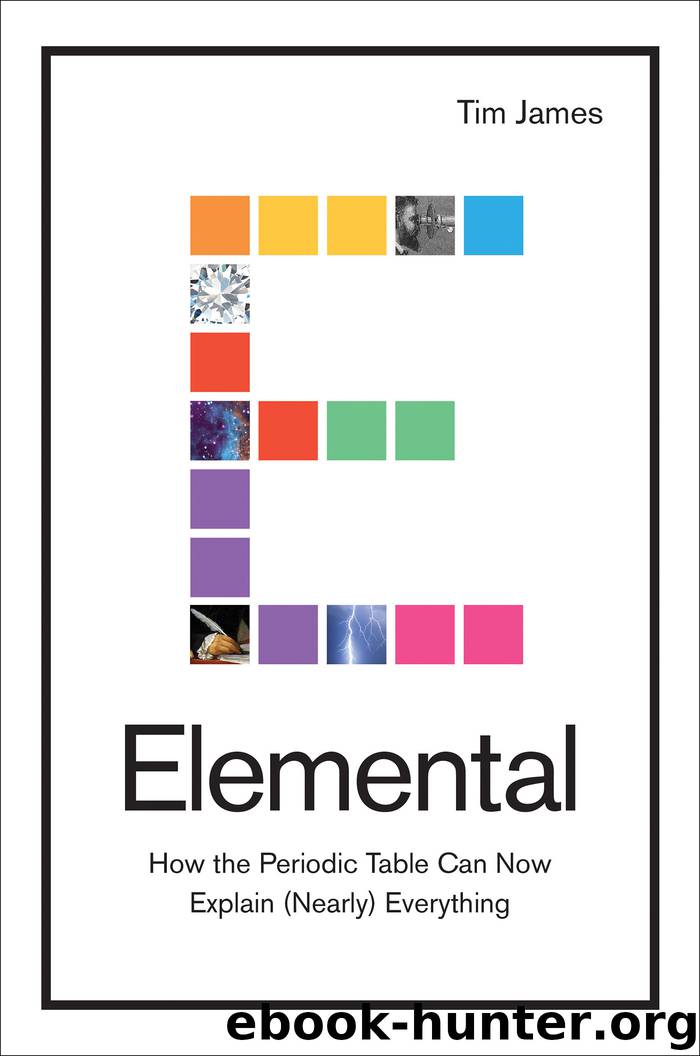Elemental by Tim James

Author:Tim James [James, Tim]
Language: eng
Format: epub
ISBN: 9781468317022
Publisher: The Overlook Press
Published: 2019-04-15T04:00:00+00:00
WHY DO METALS CONDUCT AT ALL?
As you read from left to right across the periodic table you’re gradually increasing the number of protons in the nucleus. The more proton charge you have, the more electrons will be pulled inward and the smaller your atom becomes, meaning we see a decrease in atom size along each row.
Atoms on the left are therefore big and diffuse with great, floppy orbitals. Their electrons are also a long way from the nucleus with nothing much keeping them in place. This makes them ideal for sharing electrons with other atoms since the electrons have very little incentive to stay put.
When you get these bulky atoms together, their orbitals start mixing not just on a one-to-one basis but over the entire population. The atoms are so happy to share that when you solve the Schrödinger equation to describe millions of metal atoms, the result is a kind of mega-orbital—a turbulent free-for-all, which physicists call “the electron sea.” This network of overlapping orbitals means electrons can easily slosh from one side of the structure to the other.
Touch any piece of metal and beneath your fingertips you’ve got a swarm of electrons flitting back and forth at will. These movements are random but if we can persuade the electrons to travel in one direction at the same time we have an electric current.
In smaller molecules, formed by elements on the right, gaps between the orbitals make it hard for electrons to move, so they won’t conduct. That doesn’t mean, of course, that it’s impossible to force an electron through an insulator. Teflon, the most insulating material on Earth, can still be made to conduct but you need a fierce amount of energy to persuade the electrons to hop across the orbital gaps.
A substance with a conductance over 1 million siemens per meter is classified as a conductor while a substance below 0.01 is an insulator. Admittedly there’s a huge gap between 0.01 and 1 million siemens per meter, but very few substances fall in this region. Those that do are deemed “semi-conductors.”
Download
This site does not store any files on its server. We only index and link to content provided by other sites. Please contact the content providers to delete copyright contents if any and email us, we'll remove relevant links or contents immediately.
| Electron Microscopes & Microscopy | Experiments & Projects |
| Measurement | Microscopes & Microsocopy |
| Scientific Instruments | Telescopes |
| Time | Methodology & Statistics |
Thing Explainer by Randall Munroe(3315)
The Elements by Theodore Gray(2424)
Make by Mike Westerfield(1966)
The Meaning of it All by Richard Feynman(1905)
Science Experiments You Can Eat by Vicki Cobb(1438)
Every Tool's a Hammer by Adam Savage(1437)
The Perfectionists by Sara Shepard(1422)
Raspberry Pi Electronics Projects for the Evil Genius (Tab) by Norris Donald & Norris Donald(1381)
Martin Gardner's Science Magic by Martin Gardner(1346)
The Perfectionists by Simon Winchester(1268)
Elephants on Acid: And Other Bizarre Experiments by Alex Boese(1246)
Synchrotron Light Sources and Free-Electron Lasers by Eberhard J. Jaeschke Shaukat Khan Jochen R. Schneider & Jerome B. Hastings(1232)
Elephants on Acid by Boese Alex(1230)
Handbook of Modern Sensors by Jacob Fraden(1218)
Hands-On Genetic Algorithms with Python by Eyal Wirsansky (2020) by Unknown(1212)
Tesla by Carlson W. Bernard(1181)
The Science of Food by Marty Jopson(1161)
The Meaning Of It All by Richard P. Feynman(1122)
125 Physics Projects for the Evil Genius by Silver Jerry(1115)
